
2Market capitalization based on basic shares outstanding
3Fully diluted shares outstanding (“SO”) includes 30 million shares greenshoe, CEO Award (SEC Form S-1/A Filing (February 16, 2017) (“Snap S-1”) at page 89, options outstanding using the treasury method, and RSUs.
Executive Summary
Snapchat’s first-mover advantage in vertical video and short-lived/disappearing images in combination with its engaging products has positioned it as the most significant competitor to Facebook in social networking. Snapchat’s strong management team, impressive user growth, and engaging products enable Snapchat to accelerate top line growth and gain market share in the $70 billion spent on US television ads annually.5 The company’s IPO pricing range of $14-16 per share gives the company a market capitalization value between $17-19 billion, representing a 15-17x 2017 forward sales multiple (similar to Facebook’s and Twitter’s IPO sales multiple). On a fully diluted basis, Snapchat’s market capitalization is between $20-23 billion. Although Snapchat’s valuation might not seem stretched given its strategic value as potentially the next leading social network, the company’s declining user growth in addition to competition from Facebook, Instagram, and others present an interesting investment discussion of the opportunities and risks given the IPO’s valuation and future financial expectations.
Reinventing the Camera
Founded in 2011, Snapchat is an image messaging and multimedia mobile application which initially differentiated itself by allowing users to share images that are ephemeral and self-deleting. The company calls itself a “camera company” and wants to reinvent the camera to improve the way people live and communicate.6 The company’s headquarters are in Venice, California with regional offices in London, New York, Seattle, Sydney, Toronto and Ukraine. With over 158 million daily active users (“DAU”) creating 2.5 billion Snaps per day in 20 different languages, $936 million in revenues expected in 2017,8
The Opportunity
Snapchat has scaled its business rapidly from inception, growing to $404 million in gross revenue in 2016, and projected to grow to nearly $1.8 billion of gross revenue by 2018.6 According to Snapchat’s SEC Form S-1/A filing, DAUs spend an average of 25 to 30 minutes and visit the app more than 18 times a day.9 Relative to the competition, there is a sense that Snapchat is a better reflection of your “real” life whereas Facebook and Instagram portray only an embellished life. With revenue per user of only $2.14 in North America compared to Facebook’s $19.81, Snapchat has significant room for monetization upside. The company’s management team also has proven their ability to innovate, adapt, and create a product that 18-34 year olds (a demographic coveted by advertisers) prefer over Instagram. There is significant strategic value in Snapchat that Facebook and perhaps other very large companies might want to acquire.
The Risks
The company’s DAU growth has declined significantly in the last two quarters with only 3.3% q/q growth in the December 2016 quarter. The user data for Facebook (483 million DAU, 5.7% q/q growth) and Twitter (218 million MAU, and 100M+ DAUs, 6.9% q/q growth) were stronger at their IPOs than Snapchat’s. Snapchat has raised $2.7 billion from prominent US and global investors, but now only has $987 million in cash and lost $678 million in cash in 2016. This IPO is necessary to fund the company’s near-term cash burn and contract commitments to Google Cloud ($2 billion), Amazon Web Services ($1 billion), and others ($547 million) over 5 years.10
Highlights:
- Innovative co-founders and a strong, experienced management team
- Major brand and publishing partnerships including Burberry, Calvin Klein, CNN, Cosmopolitan, Domino’s, ESPN, Gucci, GE, NFL, People, Starbucks, Taco Bell, Victoria’s Secret
- 158 million DAU in Q4 2016, creating 2.5 billion snaps per day driving organic traffic and brand awareness
- Innovative use of social media channels, photos, Lenses, Stories, and glasses (called “Spectacles”)
- Significant value proposition for a strategic buyer who wants to target Millennials and Generation Z
Potential Concerns:
- Significant competition, especially from Facebook and Instagram
- Slowing growth in DAU and uncertainty around Snapchat’s ability to expand beyond its current demographic
- Company was negative $678 million in 2016 free cash flow11 and has $3.5 billion+ of contractual commitments
- IPO shares will not have voting rights
Goodwater Survey
We conducted a survey in January 2017 with 2,076 participants from the US and discovered that Snapchat has 16% share of “favorite social apps” among leading social apps for younger users (under 30 years old), but only 3% share among older users. Forty percent of respondents said Facebook was their favorite app 6 months ago compared to 38% saying it was their favorite app now, while 14% of respondents said Snapchat was their favorite app 6 months ago and 16% said it is their favorite app now. The suggested market share increase of Snapchat was more muted in the over 30 years old segment.


Users under 30 years old greatly prefer Snapchat Stories (41% for Snapchat vs. 12% for Instagram), whereas older users slightly prefer Instagram Stories.


Among younger users, Snapchat is tied with Instagram for 3rd place among time spent on social apps, whereas for older users it is in second-to-last place among comparable large social apps.
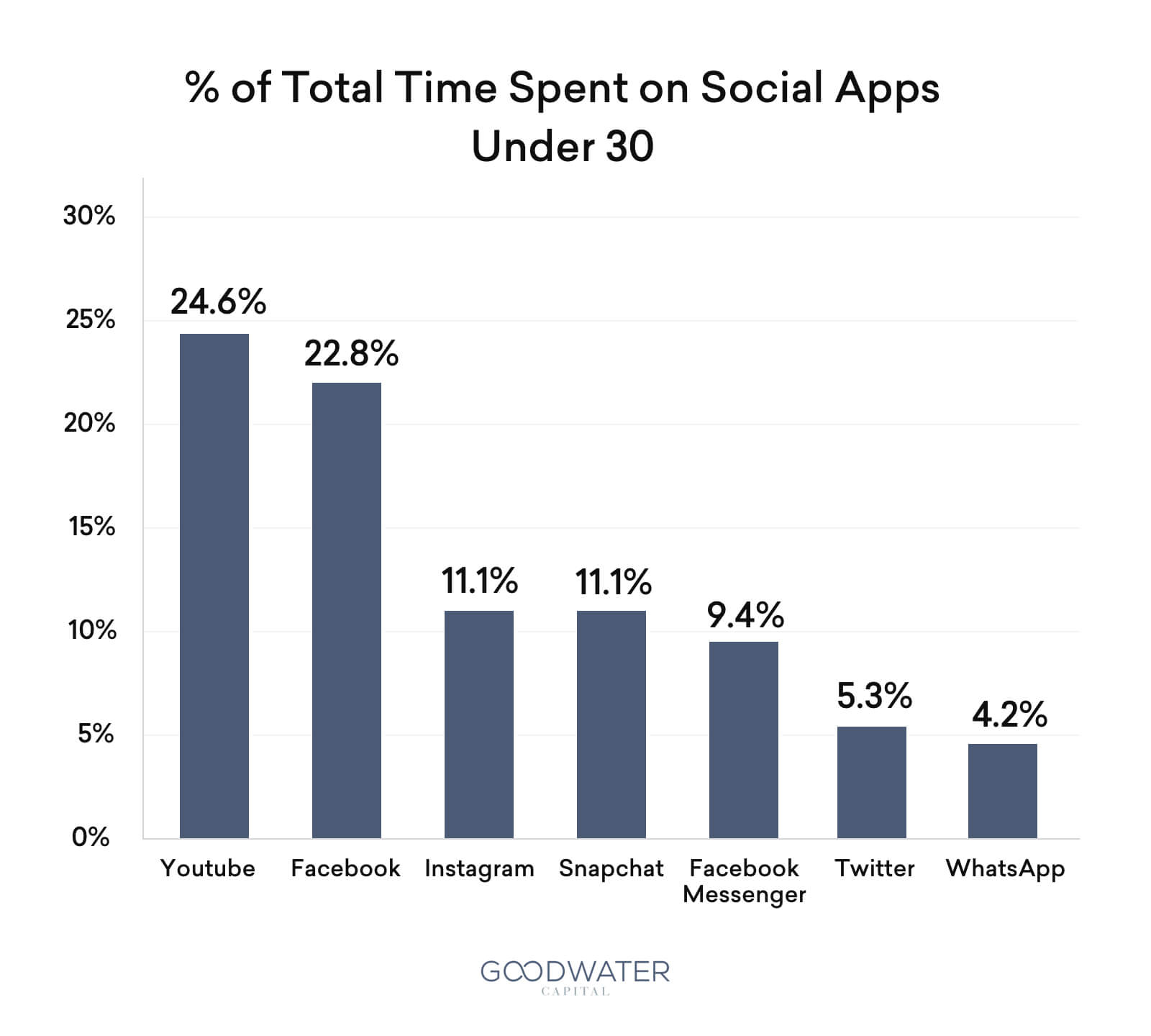

Survey participants were U.S. users evenly distributed across geography, age, and income. This survey corroborates the younger Snapchat demographic and the shift in their habits stated in Snapchat’s SEC Form S-1/A filing (85% of Snapchat users are between 13-34 years old, with the largest demographic in the 18-24 year old range).12 Since younger people are spending more time on mobile devices and sharing videos, Snapchat seems to be well positioned for the growth expected in mobile and video digital advertising.
Snapchat Business Overview
The company calls itself a “camera” company and Evan Spiegel, Snapchat’s CEO, also describes the company as an “entertainment” company.13 When Snapchat launched in September 2011, users immediately enjoyed how their photos were ephemeral and how easily their photos could be shared with others. Snaps (i.e. photos or videos on Snapchat) are deleted from Snapchat’s servers after they are viewed and a copy is saved only if the sender or recipient takes a screenshot or saves it. The company says many people have used Snapchat primarily to send “selfies,” digital self-portraits captured.14 Snapchat has evolved from being just an ephemeral messaging app to a content and publishing media platform. The company’s business can be broken down into three primary segments: Camera, Communications, and Content.
- Camera: Snapchat asserts the belief that “reinventing the camera represents the greatest opportunity to improve the way people live and communicate.”15 Snapchat’s Camera serves as the interface for its creative tools. Most of these tools are available on the Preview screen after a user takes a Snap, but Lenses are used on the Camera screen before taking a Snap.16 Please see the below diagrams, which identify locations and features of the Camera, Preview, and Lenses.Lenses are free and some of the Lenses are sponsored by advertisers. Adweek reported that these ad formats cost $750k for holidays and big-ticket events like the Super Bowl. Taco Bell’s Cinco de Mayo campaign resulted in 224 million views in one day, beating Gatorade’s Super Bowl campaign of more than 165 million views.19



Source: Snap Inc.’s SEC Form S-1/A filing20Source: Snap Inc.’s SEC Form S-1/A filing21Snapchat’s most recent product is called Spectacles, sunglasses that make Snaps. Spectacles connect with Snapchat and they capture video using a wide-angle camera on the side of the glasses.


Source: Snap Inc.’s SEC Form S-1/A filing22Snapchat believes that “the camera is the starting point for the future of mobile interaction, entertainment, and education.”23
- Communications: The first version of the application included a Chat Service that allowed people to send Snaps to their friends—hence the name “Snapchat”. In 2014, the company developed text-based chat because sometimes Snaps are not able to provide the level of detail and specificity required by certain conversations.24 Whether or not Snapchat users edit their photos or videos, they can send these photos to their friends individually or broadcast them to the public. Snapchat benefits from the frequency with which its user base communicates with one another, because each message invites a user back to the application when they receive a notification. The impact of that frequency has in part driven users to visit Snapchat more than 18 times each day on average.25

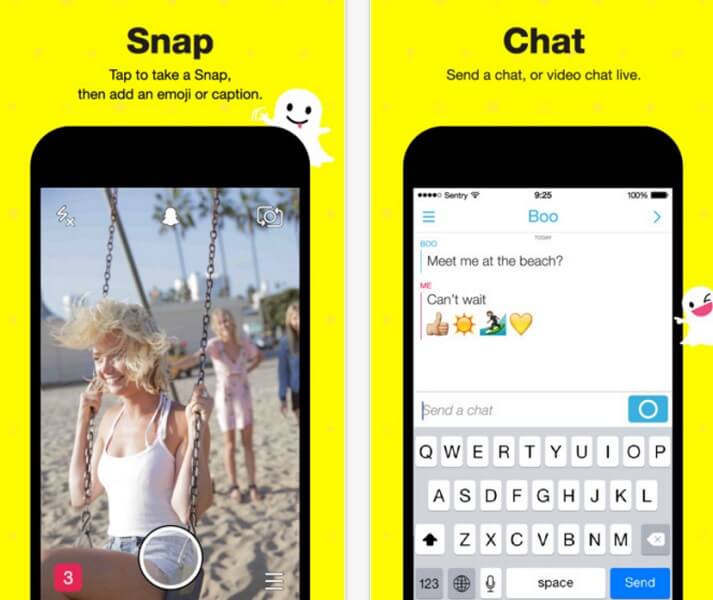
Source: Images by Buffer and tripoto26In October 2013, Snapchat introduced My Story. Stories are collections of Snaps viewed in chronological order that expire within 24 hours. Every user on Snapchat has their own personal and ephemeral Story that can be viewed by all of their friends.27 Stories has grown into one of Snapchat’s most popular products with over 25% of its Daily Active Users posting Snaps to their Stories every day.28 Below are a diagram and a screenshot of Stories. While the Chat Service brings people back to the application frequently to communicate with their friends, the Storytelling Platform provides a unique variety of personal and professional content. As a result, Daily Active Users spend an average of 25 to 30 minutes on Snapchat every day.29


Source: Snap Inc.’s SEC Form S-1/A filing30Similar to other social networking messaging apps, Snapchat allows its users to also send text messages and engage their friends with audio and video call functions. Snapchat does not anticipate placing advertisements as people chat or speak with others because the company does not want to disrupt the flow of communication and ruin the user experience with advertising.
- Content: In January 2015, Snapchat created Publisher Stories where the company allowed publishers, who could invest in producing high-quality editorial content for Stories, to attach long-form content to each Snap in their Story. Users simply swipe up on a Snap to access the attachment.31 Today, dozens of partners around the world, like Vogue and NBC, create Publisher Stories for Snapchat every day. Snapchat enters into agreements with many of these partners that allow them to earn a revenue share on advertisements in their Publisher Stories. Users can easily subscribe to their favorite Publisher Stories and receive daily updates.32 Snapchat also has Live Stories, which provide real-time highlights of all sorts of different newsworthy events, created by its community and curated by Snapchat. Users simply submit their Snaps to Live Story, and Snapchat takes care of the rest.33 With over 158 million DAUs34 (consisting of mostly the Millennial and Generation Z demographic), Snapchat has the future audience that both advertisers and brands want to target. The company has already attracted many of the top brands (Burberry, Calvin Klein, CNN, Cosmopolitan, Domino’s, ESPN, Gucci, GE, NFL, People, Starbucks, Taco Bell, Victoria’s Secret) and works with ad and content partners to service these brands. Snapchat’s content is likely the company’s biggest monetization opportunity. Monetization of content and revenue sharing occurs periodically between Stories. These interstitial ads are effective in that they take up the entire screen versus competitors’ ad formats that might be a smaller banner ad or part of a newsfeed. Most of the big media companies are partnering with Snapchat to address the younger audience. However, smaller publishers find it difficult to partner with Snapchat due to the high cost of entry ($500k+) on the platform. Below is a visual example of how ads are placed in Snapchat’s Stories platform. On average, over 60% of all Snap Ads are watched with the sound on.35

Source: Snap Inc.’s SEC Form S-1/A filing36The company designed Snap Ads to be skippable because it wants to give users the choice whether or not they want to watch an advertisement.37 Snap Ads can have interactive capabilities/attachments, providing a way for users to respond to a Snap Ad while viewing it.38
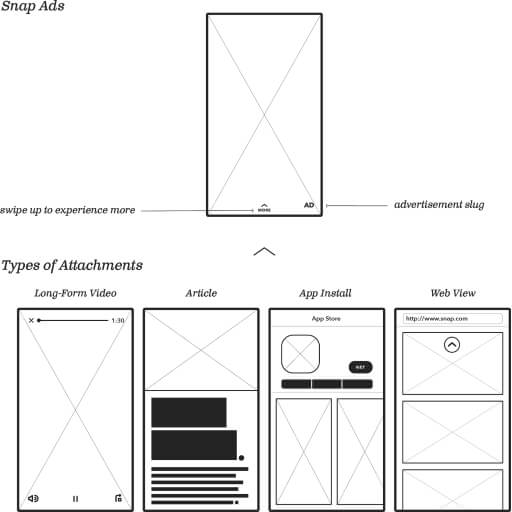

Source: Snap Inc.’s SEC Form S-1/A filing39The company offers several different ways to buy advertisements on Snapchat. Its direct sales team works with large advertisers and agencies around the world. Many of Snapchat’s content partners, including publishers like Viacom, also sell Snapchat’s inventory. Advertisers can also work with Snapchat Ads Partners like TubeMogul and 4C, to purchase advertising from Snapchat through its advertising API40 (no revenue sharing in this situation). Snapchat verifies and measures the delivery and viewability of its partners’ ads. A recent study across 12 campaigns found that 92% of the measured campaigns drove a positive lift in in-store sales, with the campaigns exceeding Oracle Data Cloud norms on all key metrics. For example, two home care campaigns drove over $100 in revenue per thousand impressions—a return on advertising spend in excess of 6x.41 Snapchat has great products and tools that are attracting big advertisers and allowing these advertisers to accurately measure their return on investment.
For a summary of all the products and features that Snapchat has created in its short history, please see the below timeline of product innovation.

Source: Snap Inc.’s SEC Form S-1/A filing42
Market Overview and Key Trends
Snapchat is benefiting from several strong market trends. IDC projects that worldwide advertising spend will grow by 18% from $652 billion in 2016 to $767 billion in 2020. Mobile advertising is the fastest growing segment of this market, and is expected to grow 3x from $66 billion in 2016 to $196 billion in 2020.43 According to forecasts by eMarketer and IDC for 2016, respectively, U.S. adults will spend 26% of their time consuming media on mobile devices, while only 13% of U.S. advertising will be spent on mobile.44 This shift to mobile adverting from traditional TV ad spend favors Snapchat’s mobile strategy and young demographic.
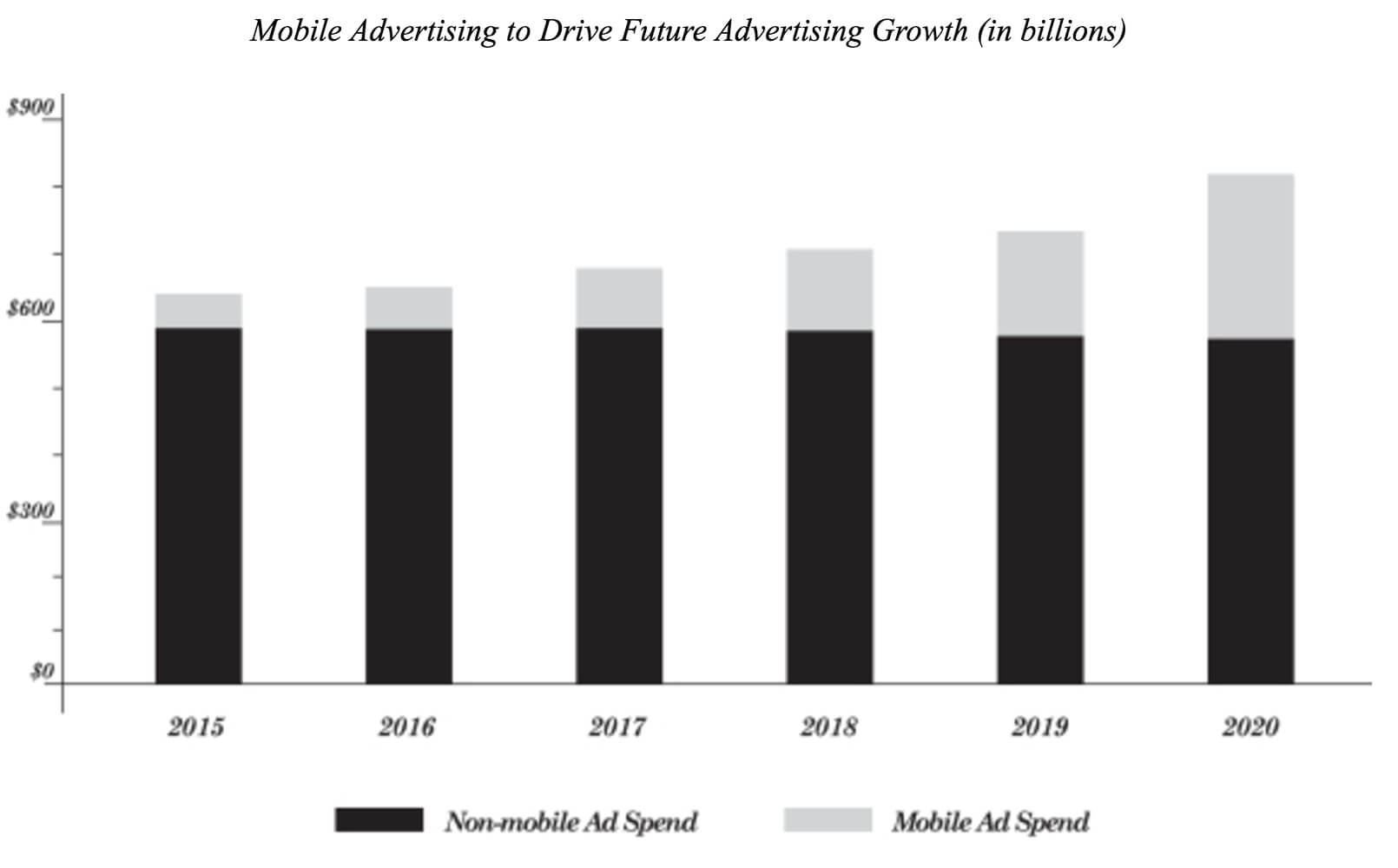

eMarketer also projects that people will continue to increase the time they spend on mobile compared to desktop and television. According to Nielsen, people between the ages of 18 and 24 spent 35% less time watching traditional (live and time-shifted) television in an average month during the second quarter of 2016 compared to the second quarter of 2010.46


(1)Represents the average time spent per day by U.S. adults on mobile, desktop, and television as a percentage of total time spent per day consuming major media. Source for Change in Time Spent Watching TV is Nielsen
Snapchat’s user base is also quickly expanding into older demographics, with more than 50% of its U.S. daily new users coming from the over 25 age group. Certain of Snapchat’s more mature markets may skew older. For example, approximately half of all smartphone users in Norway use Snapchat daily according to eMarketer, and on average approximately 46% of those users are over 35.48
Digital ads continue to gain market share at the expense of newspapers and magazines and is expected to be 26% of 2020 total advertising spend, up from 16% in 2016 (see Charts 1 and 2 below). We foresee these digital advertising trends to continue to outpace other forms of advertising as big data analytics, artificial intelligence, and social media will allow advertisers and brands to better target consumer interests and habits.


The Social digital media ad market is currently $32 billion worldwide, and is expected to grow to over $63 billion by 2020, of which the US will make up 47% of overall sales. Within digital media, only video and mobile is expected to grow faster at a 29% and 28% annual growth rate, respectively. Snapchat is well positioned as its products are squarely focused on mobile, video, and social media content.

Most of the world’s advertising spend is concentrated in a few developed markets. The top ten advertising markets command over 70% of overall advertising spend and nearly 85% of mobile spend, according to IDC. Over 60% of Snapchat’s DAU come from countries on this list, including over 60 million DAU in the United States and Canada, and over 10 million DAU in the United Kingdom. Snapchat believes that the concentration of its DAU in these developed markets will help them address the global advertising market opportunity.49

*Excludes Hong Kong
Key Risks
There are a number of risk factors to Snapchat’s long-term prospects, including:
- Snapchat’s growth and success depend heavily on user growth and engagement. The majority of its users are 18-34 years old. This demographic may be less brand loyal and more likely to follow trends than other demographics. These factors may lead users to switch to another product, which would negatively affect Snapchat’s user retention, growth, and engagement. For example, Instagram introduced a similar stories product, which could hamper Snapchat’s ability to attract new users and retain existing user engagement. DAU’s only grew 3.3% q/q (down from the prior quarter of 7% q/q growth). Snapchat also may not be able to penetrate other demographics in a meaningful manner.
- The company has significant competition, especially from Facebook and Instagram. In addition, Snow is a competitor which offers a Snapchat-like product that has performed well in China, Korea, Japan, and other Asian countries. Facebook is further ahead of Snapchat in many areas, including its analytical tools which help customers measure the ROI of their ad spend. Snapchat has strong partnerships and brands already working with the company. It will be up to the company’s talented and experienced management team to monetize these partnerships and catch up to the competition.
- Snapchat is a media company and is exposed to the macro risks of weakening economies and lower advertising spending.
- The shares offered in the IPO (Class A shares) have no voting rights. Class B shares have one vote per share and Class C shares have 10 votes per share (only Mr. Spiegel and Mr. Murphy hold Class C shares). As a result, Mr. Spiegel and Mr. Murphy, and potentially either one of them alone, have the ability to control the outcome of all matters submitted to stockholders for approval, including the election, removal, and replacement of directors and any merger, consolidation, or sale of all or substantially all of Snapchat’s assets.
- The company switched accounting firms from PWC to E&Y in April 7, 2016 after PWC identified material weaknesses in Snapchat’s internal controls over financial reporting.
- The company already sees seasonality in its business, which might indicate a slowing and maturing of the business.
- Snapchat relies on Google Cloud and Amazon Web Services to host the vast majority of the company’s computing, storage, bandwidth, and other services. The company has committed to spend $2 billion with Google Cloud and $1 billion with Amazon Web Services over the next 5 years.51
- Snapchat is significantly cash flow negative with $547 million of contract obligations (not including Google Cloud and Amazon Web Services commitments).
- The company needs an IPO to raise cash. Private market investments might be limited since Snapchat already has funding from China, corporations, and long-only firms.
Summary Financials & Projections
Without company guidance or broker research estimates, we made an illustrative pro forma with our calculation of free cash flow52 using Facebook’s current margin profile as a rough guide to Snapchat’s long-term margins and ARPU to approach Twitter’s ARPU.
High level assumptions:
- Overall gross revenue growth from $404 million in 2016 to $14.8 billion by 2027
- Free cash flow from -$703 million in 2016 to $4.3 billion by 2027
- 49% of EBITDA margins by 2027, up from -121% EBITDA margins in 2016
- 41% operating margin by 2027
- Targeting profitability in 2020
Snapchat’s quarterly ARPU is growing 243% y/y, which is much faster than both Facebook’s and Twitter’s ARPU at the time of their IPOs (using quarterly data from December 2011 and June 2013, respectively). Both Facebook and Twitter have been able to increase their ARPU since going public. However, Facebook has continued to see growth in ARPU whereas Twitter’s ARPU has declined year-over-year in Q4 2016.

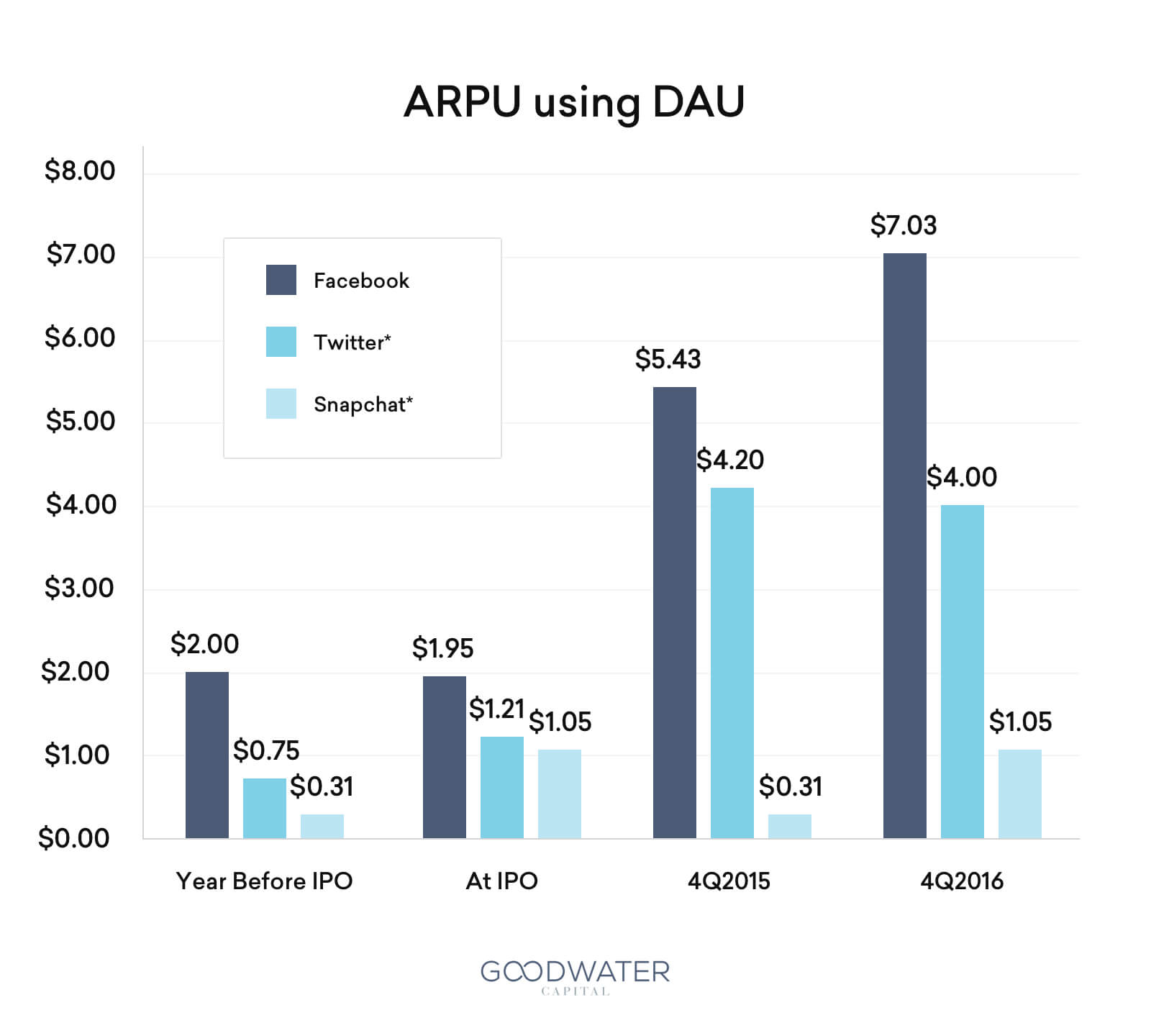
*Assumes 50% DAU/MAU ratio

The below public comparables53 indicate that (as Snapchat matures) its valuation could trade around a 10-13x forward EBITDA multiple if it trades around the median of the below comp set.
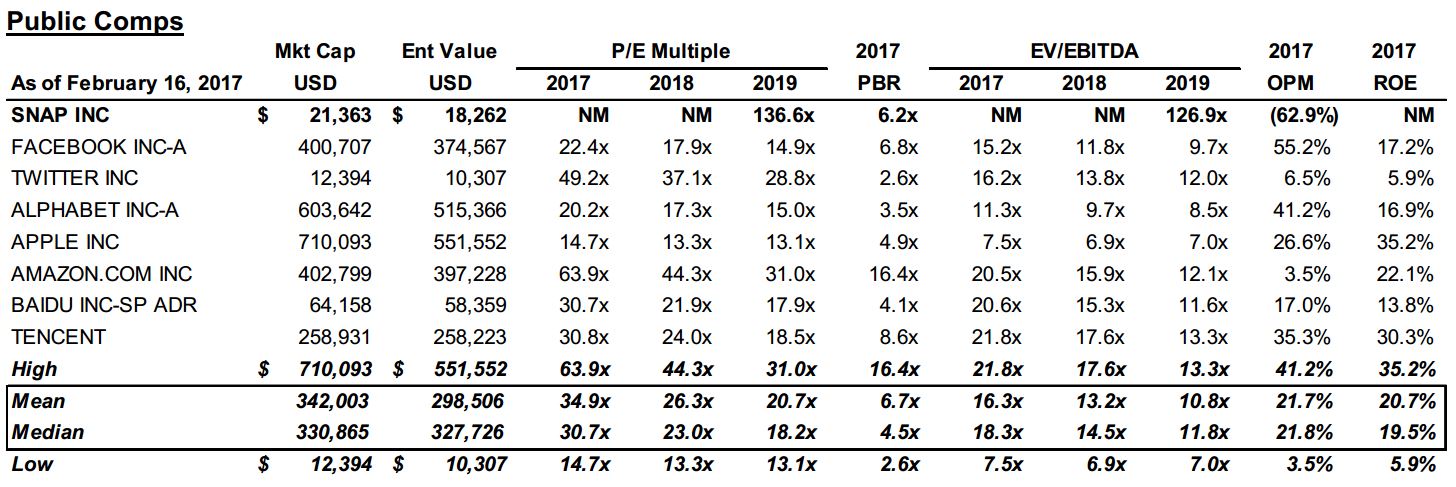
Snapchat’s DAU multiple metrics will likely be somewhere between Facebook’s and Weibo’s. The other companies below did not disclose DAU figures in their most recent filings.

**Measured in millions. MAU/DAU data as of 4Q16 for Facebook, Twitter, Line, and Kakao. 3Q16 data for others
Source: Company reports and Bloomberg as of February 16, 2017
Relevant M&A Outcomes
- WhatsApp (Feb 2014): acquired for $19 billion by Facebook
- Instagram (Apr 2012): acquired for $1 billion by Facebook
- YouTube (Oct 2006): acquired for $1.65 billion by Google
Competition
Snapchat competes with a number of incumbents and new companies in a few different media/entertainment categories for user time spend, including:
- Incumbent SNS brands: Facebook, Instagram, Apple iMessage, Gmail, FB Messenger, WhatsApp, WeChat, Line, Kakao
- Startup SNS brands: Snow, Houseparty
- Online video content: Netflix, Amazon Instant Video, Hulu, YouTube, iTunes, HBO Now
- Offline video content: Multichannel video programming distributors (e.g. Comcast, Spectrum, Dish, DirectTV, Cox, etc.), HBO, Showtime, Sony Pictures, Paramount Pictures, etc.
Executive Team
- Evan Spiegel (co-founder & CEO): Evan studied product design at Stanford University but left shortly before completing his degree to focus on Snapchat.
- Bobby Murphy (co-founder & CTO): Bobby leads Snap’s engineering, product, and research teams. Graduated from Stanford University in 2010 with a mathematics and computational science degree.
- Imran Khan (CSO): Prior to being Chief Strategy Officer, Imran was the Head of Global Internet Investment Banking at Credit Suisse where he advised on more than $45 billion in M&A and financing transactions. Prior to Credit Suisse, he was a Managing Director at JP Morgan and graduated from the University of Denver.
- Tom Conrad (VP of Product): CTO at Pandora, Kenamea, Pets.com, Documentum, Apple, University of Michigan
- Nick Bell (VP of Content): SVP at Newscorp, wickedcolors.com, founder of teenfront.com, education at RGS Newcastle
- Mary Ritti (VP of Communications): Partner at North of Nine Communications, Managing Director at BursonMarsteller, Associate at Copithorne & Bellows, Nokia, Rice University and Chestnut Hill College
- Basic share count of 1,157 million shares outstanding plus 30m shares in greenshoe option
- Market capitalization based on basic shares outstanding
- Fully diluted shares outstanding (“SO”) includes 30 million shares greenshoe, CEO Award (SEC Form S-1/A Filing (February 16, 2017) (“Snap S-1”) at page 89, options outstanding using the treasury method, and RSUs.
- “Snapchat,” Wikipedia (https://en.wikipedia.org/wiki/Snapchat).
- Statista.com (https://www.statista.com/statistics/259974/tv-advertising-revenue-in-the-us).
- Snap Inc.’s SEC Form S-1/A Filing (February 16, 2017) (“Snap S-1”).
- eMarketer September 6, 2016 article “Snapchat Ad Revenues to Reach Nearly $1 Billion Next Year”.
- IDC Snap S-1, at page 121.
- Snap S-1, at page 64.
- Snap S-1, at page 86.
- Snap S-1, at page 4.
- Snap S-1, at page 123.
- Ericsson’s The Networked Society Blog May 27, 2015 article “What is Snapchat? Entertainment, says CEO Evan Spiegel at Code Conference”
- Snap S-1, at page 93.
- Snap S-1, at page 1.
- Snap S-1, at page 99.
- Adweek May 11, 2016 article “Taco Bell’s Cinco de Mayo Snapchat Lens Was Viewed 224 Million Times”
- Snap S-1, at page 100.
- Snap S-1, at page 100.
- Snap S-1, at page 98. Photo image by screen shot of YouTube May 5, 2016 video “Snapchat Taco Bell Filter – Cinco De Drinko”
- Snap S-1, at page 96. Photo image by cnet July 16, 2014 article “Snapchat boosts photo location tagging with ‘geofilters’”
- Snap S-1, at page 100. Photo image by Business Insider Sept 24, 2016 article “5 reasons Snapchat’s new Spectacles could succeed where Google Glass failed”
- Snap S-1, at page 106.
- Snap S-1, at page 102.
- Snap S-1, at page 103.
- Photo images by Buffer’s March 31, 2016 article “Snapchat Chat: Everything You Need to Know About Snapchat’s Excellent Messaging App” and tripoto’s “Are you an Travel Junkie?12 Must have travel apps” (https://www.tripoto.com/trip/are-you-an-travel-junkie-12-must-have-travel-apps56e593a889059)
- Snap S-1, at page 94.
- Snap S-1, at page 95.
- Snap S-1, at page 104.
- Snap S-1, at page 103. Image by “How to Watch Public Snapchat Stories,” wikiHow (http://www.wikihow.com/Watch-Public-Snapchat-Stories)
- Snap S-1, at page 104.
- Snap S-1, at page 104.
- Snap S-1, at page 104.
- Snap S-1, at page 1.
- Snap S-1, at page 111.
- Snap S-1, at page 112.
- Snap S-1, at page 112.
- Snap S-1, at page 113.
- Snap S-1, at page 113-114.
- Snap S-1, at page 118.
- Snap S-1, at page 117.
- Snap S-1, at page 96.
- Snap S-1, at page 121.
- Snap S-1, at page 121.
- Snap S-1, at page 121-122.
- Snap S-1, at page 123.
- Snap S-1, at page 122-123.
- Snap S-1, at page 123.
- Snap S-1, at page 123.
- Snap S-1, at page 123.
- Snap S-1, at page 72.
- Free Cash Flow calculation in Snap S-1, at page 60 is net cash used in operating activities less purchase of property and equipment. Our Free Cash Flow calculation uses a tax-effected EBIT and adds depreciation and amortization less changes in working capital and capex. This difference in calculation is the reason for the slight variation in Free Cash Flow between Snapchat and Goodwater Capital’s calculations.
- Snap S-1, at page 55 for Snap Inc.’s 2016 Pro Forma book value and cash used for enterprise value calculation and price to book ratio (“PBR”) 2017. Market cap for Snap Inc. uses $15 share price (i.e. midpoint of IPO price range). Forward estimates are Bloomberg consensus numbers and Goodwater Capital’s estimates for Snap Inc.



